Tuesday 06 May 2025
- Thought Leadership
UK Construction Sector Report; April 2025.
Summary
- The tentative recovery in UK construction has largely come to a halt and most high frequency indicators now point towards a disappointing 2025.
- Repair & maintenance has been on a steeply deteriorating trend for several quarters and overall construction sector output has been falling in December 2024 and January 2025.
- Construction material price inflation has turned negative (-0.9% in January 2025) but wage pressures are sizable and labour shortages remain an issue for the sector.
- The UK Construction Sector Purchasing Managers’ Index has deteriorated quickly: from 57.2 points in September to 46.4 in March, new order inflow was negative in Q3 and Q4 2024.
- Interest rates will continue to fall, albeit by a smaller pace than previously expected.
- Credit risk in the sector will remain elevated, a consequence of low profit margins, fixed-price contracts, high geopolitical risk, disappointing macroeconomic conditions and poor payments performance.
- Regulatory changes such as Gateway 2 requirements, higher national insurance contributions and a minimum wage increase are also adversely impacting on the sector.
To view a pdf version, click here.

Inflation
Positively, inflationary pressures in the sector have come
down over the past quarters, thereby providing support for UK
construction companies (which predominantly operate on fixed-
price contracts). According to data from the Office for National
Statistics (ONS), construction material prices have moved lower
since mid-2022, in line with general consumer price index
developments1 In June 2022, the “all work” construction price
index had increased by 26.4% year on year (y/y), the highest
growth rate in 40 years. The “repair and maintenance” (24.7%)
and the “new housing” sub-indices (24.0%) also saw immense
increases with “other new work” inflation coming in at an even
higher 30.5% y/y in June 2022.
Since then, construction material price inflation has quickly
dropped back to more sustainable levels. Since March 2023,
it has been in the single-digit range again before falling into
deflation territory in June 2023. Latest available data for January
2025 shows that the “all work” sub-index was still decreasing
by 0.9% y/y while “repair and maintenance” as well as “new
housing” reported 1.0% increases. While material price inflation
has moderated in recent years, construction companies’ operating
costs are still under pressure because of rising wages (see Labour
Market chapter below).

Meanwhile, output price inflation (prices charged by construction companies) has also eased over the past quarters2. ONS data shows that output price inflation in the sector peaked in mid-2022: in June, inflation for new construction work stood at a very high 12.1%. Repair and maintenance inflation came in at 7.9% y/y, leading to average construction sector output inflation of 10.7%.

Output price inflation in the British construction sector has dropped to 1.4% y/y in March 2024, the lowest reading since late 2020. In the second half of 2024, prices charged by UK construction companies moved higher again (reaching 3.0% y/y in December). Positively, this is supporting profit margins following several years of material price inflation severely outstripping output price inflation.
Output
UK construction did not finish 2024 on a high and ONS sectoral output data for January 2025 highlights ongoing headwinds3. Following a 0.2% month on month (m/m) drop in December, construction sector output contracted by an additional 0.2% in January, attributed to heavy rain and storms. Meanwhile, the three months moving average (which is more resilient to outliers) shows a more positive trend. In a y/y comparison, the three months to January 2025 have seen construction sector output growth of 0.9%, unchanged from the previous month and the best reading since November 2023. That said, the value still compares unfavourably against the long-term average: in 2015-19 (Covid distorts the comparison), output growth came in at an average 3.3% y/y each month.
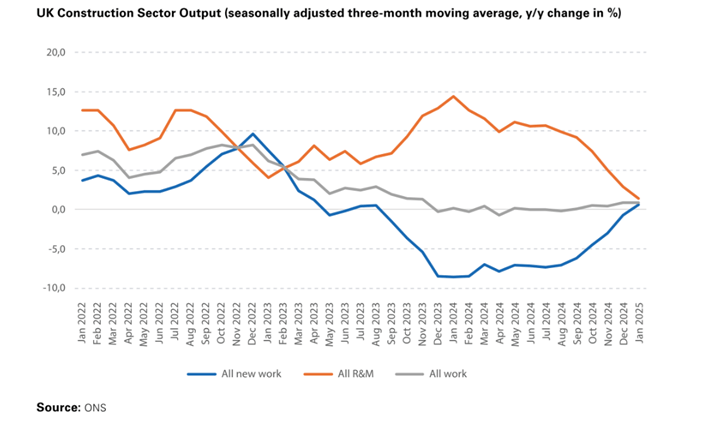
Drilling down deeper, it becomes evident that the recent y/y
output expansion is still driven by repairs and maintenance
(R&M). Over the past twelve months (February 2024 to January
2025), R&M growth averaged 9.0% y/y each month while new
work contracted by -5.5% y/y. That said, R&M activity has been
moderating for several quarters now with output growth falling
from 14.4% y/y in January 2024 to 1.4% only one year later.
Meanwhile, new work output moved higher: from -8.6% in early
2024 to 0.6% (in growth territory for the first time since August
2023) in January 2025.
Generally, construction remains a mixed bag: while private new
housing (a key component of the sector) has been growing
by 4.0% y/y in the three months to January 2025 (the best
performance in two years), infrastructure (-3.9%) and public
new housing (-16.6%) continue to contract. Private industrial
new work has been growing for four straight months now but
private commercial new work continues to fall (for the thirteenth
consecutive month).
Labour Market
Largely, the UK labour market has performed solidly over the past years. That said, the unemployment rate has increased somewhat last year: between Q4 2023 and Q4 2024, it grew from 3.9% to a still low 4.4%4. In the construction sector, employment has fallen marginally in 2024: from 2.148m workers at the beginning of the year to 2.140m in Q4. UK construction accounts for 6.3% of total employment in the country but its importance has diminished over the past years. While employment in the UK has risen by around 797k workers (+2.4%) since the start of the Covid pandemic, the construction sector has lost 7.0% of its jobs, equivalent to 161k workers5.
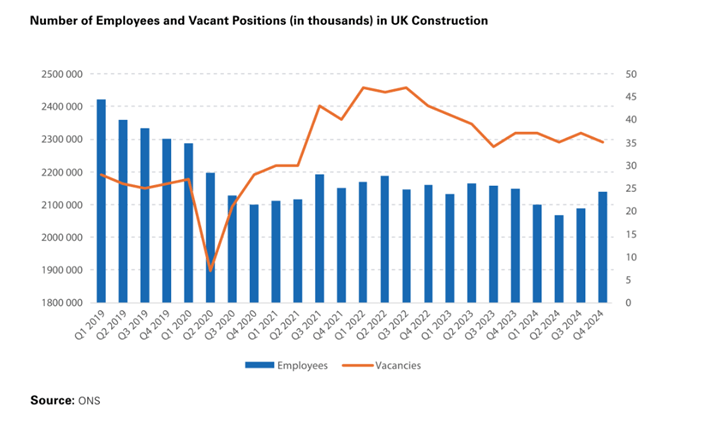
Meanwhile, the sector continues to struggle to attract workers
to fill open positions though. ONS data shows that while the
number of job vacancies in the UK has dropped from 930k in Q4
2023 to 820k in Q4 2024, figures remained more or less stagnant
in the construction sector (37k vacancies in late 2023 compared
against 35k open positions in Q4 2024). Compared against pre-
Covid years, the construction sector has seen a sizable rise in job
vacancies (from 26k in Q4 2019 to 35k five years later) and the
job vacancy ratio, which measures the number of open positions
per 100 jobs in the sector has also moved higher: from 1.7 to now
2.36.
Furthermore, wages continue to increase, thereby reducing
companies’ profitability. Positively, recent data from the ONS
shows that construction is recording below-average pay rises.
In the twelve months to January 2025, average annual earnings
growth stood at 4.7% y/y. While this is high in a historical
comparison, it is far behind sectors like accommodation and food
services (7.4%) and retail trade and repairs (8.0%). Overall, 17 out
of 24 sectors covered by the ONS witnessed higher wage growth
than the construction sector in February 2024 to January 20257.
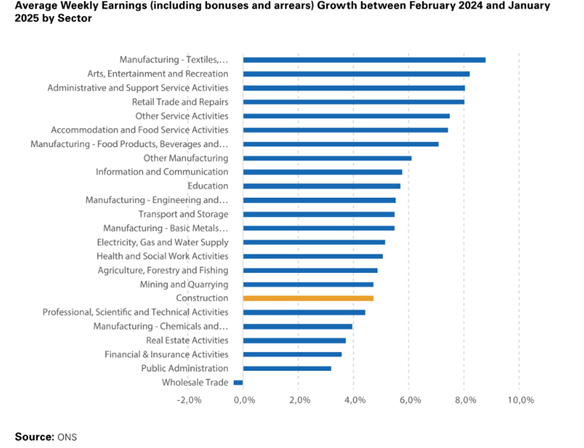
That said, construction, like all other sectors, will have to deal with higher national insurance contributions from April 2025 onwards. The 7% increase of the country’s minimum wage will probably not directly impact on the industry (as wages tend to be higher) but the incoming change has the potential to impact on salary structures and pay bands indirectly in order to reflect the new, higher salary floor.
Amidst a persistently tight labour market, construction companies will hence have to brace for higher wage costs going forward.
Outlook
The outlook for UK construction has darkened since the start of the year as macroeconomic
conditions have deteriorated, high frequency data has softened and confidence indicators
have tumbled, caused by a mix of domestic and foreign developments. Credit risk continues to be a source of concern with UK construction already accounting for an above- average share of all insolvencies in the country.
Macroeconomics
Economic conditions have deteriorated over the past months and
several forecasters, including the Bank of England, have lowered
their 2025 real GDP growth projections. The Bank has halved its
forecast from 1.5% to now 0.75% in its Monetary Policy Report
in February and the British Chamber of Commerce and the
Office for Budget Responsibility have also carried out downward
adjustments in early 2025. This was caused by the fallout of
the UK government’s Autumn Budget which foresees higher
wage costs and national insurance contributions for companies.
Subsequently announced social welfare spending cuts and tighter
fiscal policy have also negatively impacted on growth prospects.
Furthermore, the escalating trade tensions between the US
and the rest of the world also have adverse effects on growth
prospects, both domestically and internationally.
Consumer price inflation has increased somewhat over the past
quarters also: from 2.0% in June 2024 to 3.0% in January8
Although February has seen a small improvement (to 2.8%), it is
likely that inflation will remain higher for longer following recent
market turbulence, thereby limiting the BoE room to manoeuvre.
Although additional interest rate cuts, following those carried
out in 2024 and early 2025 are likely, the magnitude of monetary
loosening will be smaller than initially expected. Markets are now
counting on a further 50 basis points drop during the remainder of
2025, compared with 75 basis points previously.
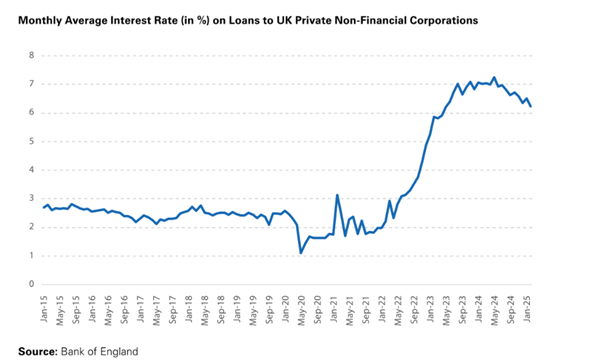
This development is noteworthy as despite the latest interest cuts, the average rate British non-financial corporations have to pay on new loans remains very elevated. Since peaking at 7.03% in November 2023, interest rates have come down to 6.23% in February 2025. However, this is still severely above the 2009-22 average of around 2%-3%9. At the same time, lending terms have tightened, thereby complicating companies’ (and households’) access to credit.
Confidence Indicators
As macroeconomic headwinds are increasing, sectoral confidence indicators are deteriorating, highlighting the widespread pessimism in UK construction. Latest Purchasing Managers’ Index (PMI) data for March shows a small improvement but with a reading of 46.4 points, the index is still close to February’s 57-month low of 44.6 points and far below the neutral 50-points line that divides expansion in sectoral activity from contraction10. The low reading is especially problematic as before the Autumn Budget in October, construction sector PMI had stood at a very high 57.2 points. In March, all three sub-sectors came in below the 50 points line with civil engineering (38.8) performing much weaker than residential construction (44.7) and commercial building (47.4).
PMI data is also showing depleting pipelines: order books have been deteriorating in the first quarter of 2025. This mirrors 2024- data from the ONS. New order inflow has been falling in Q3 and Q4 (by 9.7% y/y and 0.1% y/y respectively)11. Seasonally adjusted new order inflow (in volume terms) in UK construction has been
falling in 9 out of the 11 past quarters.
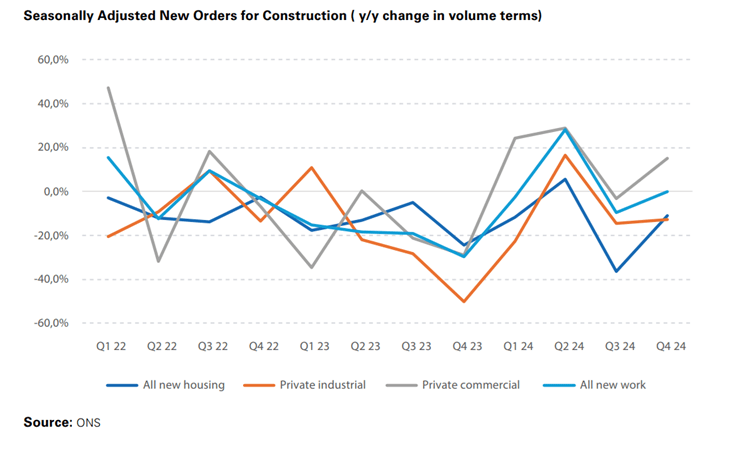
Furthermore, housing starts in Q1-Q3 2024 have slowed down to
around 100k, down from 153k in the same period one year earlier
(and far below the government’s target of 300k new homes per
annum12). In its latest set of projections from January 2025, the
Construction Products Association forecasts private housing
output to increase by 6.0% in 2025 and by 8.0% in 202613.
However, as order inflow in new housing has fallen by 13.7% in
2024, an uptick in residential building in 2025-26 seems unlikely,
especially as interest rates will remain higher for longer and
geopolitical risks have dented confidence even further.
Politics and Regulatory Environment
The construction sector featured prominently in the government’s
Autumn Budget in late 2024. The Chancellor of the Exchequer
announced investment in railway infrastructure (a Trans-Pennine
upgrade and limited work on High Speed 2 in London), earmarked
GBP5bn for affordable housing projects (with a focus on Liverpool
and Cambridge14) and GBP3.4bn for the warm homes plan
(which will fund insulations) as well as increasing spending on
school refurbishments (budget: GBP2.1bn for maintenance and
GBP1.4bn for rebuilding schools)15.. Increased spending on the
NHS will also partially support UK construction as GBP1bn has
been earmarked for repairs and upgrades. Furthermore, GBP1bn
was set aside for removing hazardous fire cladding, a result from
the Grenfell Tower Fire inquiry.
On the planning side, the government has reintroduced
mandatory housing targets for local governments (which were
abolished by the previous administration) and has pledged to build
1.5m houses during this 5-year parliamentary term. In addition, a
promised overhaul of planning laws (a major bottleneck) and hiring
an additional 300 planning officers are also measures that will
help to “get Britain building again”.16
Unfortunately, to date, reform progress has been slow, thereby
holding back building activity. As government finances are
stretched, large scale infrastructure investment during this
parliamentary term is at risk. New infrastructure orders have
already fallen in six out of the past eight quarters.
Positively, the government has finally announced building safety
levy rates (a consequence of the Grenfell Tower fire in 2017)
and delayed implementation until autumn 202617. Meanwhile,
uncertainties around newly introduced so-called Gateway 2 safety
approvals (required for high rise buildings, also a result of the
Grenfell Tower fire) is holding back 92 new construction projects
at the moment (plus an additional 641 existing blocks)18. The
current approval backlog is sizable, adding around 6 months to
project pipelines plus also causing additional costs19.
Meanwhile, ESG topics and decarbonisation targets will also
impact on construction companies going forward. Generally,
net zero policies have become less popular over the past years
and on an international stage, the topic has been put on the
backburner since the election of Donald Trump as US president.
In the UK, the government has watered down targets in the
troubled automotive industry recently, giving car makers more
time to transition from internal combustion engine cars to electric
vehicles20. That said, no changes to the goalposts for the UK
construction sector have been announced yet. With the sector
accounting for around a quarter of the UK’s carbon footprint,
emissions will need to be cut by 76% by 2035 (and reduced to
zero by 2050). Achieving these aggressive targets will require
sizable investment and seismic changes to operating models but
also provide opportunities for companies embracing change.
Credit Risk
Positively, the number of business failures in the construction sector has fallen in 2024. After three consecutive increases in 2021-23,last year saw an 8.1% drop in England and Wales (which accounts for around 94% of all company insolvencies in the UK). Overall, 4,032 construction companies went under in 2024, down from 4,388 in 2023 but still far above the pre-Covid reading of 3,217 in 2019.21

The UK construction continues to display an above-average
insolvency risk. While the sector accounts for around 6%-7%
of gross value added in the country, it is responsible for almost
17% of all insolvencies (4,032 out of 23,879 in 2024). This is
largely due to small profit margins, usually around 2%-4% and the
inability to pass on unexpected cost increases to customers due
to fixed-price contracts.22
Anecdotal evidence also suggests that payment patterns in the
sector are deteriorating again. While things improved during the
Covid pandemic, bigger companies would appear to be holding
on to cash longer again, thereby adversely impacting on working
capital requirements in their supply chain. A recent report from
Begbies Traynor, a business recovery consultancy ,shows that
the number of UK construction companies in financial distress
has risen by 58% in 202423. According to the report, almost 98k
construction companies in the UK are experiencing significant
financial stress, more than in any other sector in the economy,
with 6,830 construction companies seeing critical levels of
financial distress.
Furthermore, the rising number of employee ownership trusts
in the sector is also a source of concern, given the high amount
of EOT failures in recent quarters (often caused by too-high
committed contributions to previous owners). It remains to be
seen whether EOTs are a suitable model for the very volatile
construction sector.
Taking all factors into account, the 2025 credit risk outlook
remains challenging. Although interest rates reductions this year
will be very welcome, sectoral insolvency risk remains elevated.
With turnover expansion over the past years largely been driven
by inflation, rather than organic growth, the high degree of
economic and political uncertainty could easily derail the already
weak recovery. Greater progress on speeding up planning and
safety approvals may be needed, especially as limited contractor
capacity, a consequence of the elevated number of business
failures, could also cause delays.
Related links:
[1] https://www.gov.uk/government/collections/building-materials-and-components-monthly-statistics-2012#2025-monthly-bulletins
[2] https://www.ons.gov.uk/businessindustryandtrade/constructionindustry/datasets/interimconstructionoutputpriceindices
[3] https://www.ons.gov.uk/businessindustryandtrade/constructionindustry/bulletins/constructionoutputingreatbritain/january2025
[4] https://www.ons.gov.uk/employmentandlabourmarket/peoplenotinwork/unemployment
[5] https://www.ons.gov.uk/employmentandlabourmarket/peopleinwork/employmentandemployeetypes/datasets/employmentbyindustryemp13
[6] https://www.ons.gov.uk/employmentandlabourmarket/peoplenotinwork/unemployment/datasets/vacanciesbyindustryvacs02
[7] https://www.ons.gov.uk/employmentandlabourmarket/peopleinwork/earningsandworkinghours/datasets/averageweeklyearningsbyindustryearn03
[8] https://brc.org.uk/market-intelligence/retail-in-numbers/
[9] https://www.bankofengland.co.uk/statistics/visual-summaries/effective-interest-rates
[10] https://www.pmi.spglobal.com/Public/Home/PressRelease/ce95e791e0bf493c9cabcaff6538c527
[11] https://www.ons.gov.uk/businessindustryandtrade/constructionindustry/datasets/newordersintheconstructionindustry/current
[12] https://www.ons.gov.uk/peoplepopulationandcommunity/housing/datasets/ukhousebuildingpermanentdwellingsstartedandcompleted/current
[13] https://assets.publishing.service.gov.uk/media/66a76bf2ce1fd0da7b592e5d/UK_Energy_in_Brief_2024.pdf
[14] https://www.financial-news.co.uk/uk-budget-2024-opportunities-for-construction-sector/?utm_source=email&utm_medium=sfmc&utm_campaign=UK-FUTBU-LON_Newsletter_EM_Subscriber_Prom_08_Nov_379
[15] https://www.pbctoday.co.uk/news/planning-construction-news/labour-delivers-their-first-autumn-budget-but-is-construction-being-left-behind/145195/
[16] https://www.cityam.com/chancellor-rachel-reeves-unveils-planning-reforms-to-get-britain-building-again/
[17] https://www.osborneclarke.com/insights/building-safety-levy-delayed-rates-confirmed-uk-government
[18] https://www.housingtoday.co.uk/reeves-says-she-will-not-renege-on-building-safety-regulation-as-90-new-high-rise-projects-held-up-by-rules/5134088.article
[19] https://www.building.co.uk/focus/what-the-delays-at-the-building-safety-regulator-mean-for-high-rise-development/5134101.article
[20] https://www.bbc.com/news/articles/cj3xe7ppmn2o
[21] https://www.gov.uk/government/statistics/company-insolvencies-february-2025
[22] https://www.linkedin.com/pulse/profitability-shrinking-margins-uks-construction-tpr7c/
[23] https://www.begbies-traynorgroup.com/news/business-health-statistics/historic-jump-in-the-number-of-firms-in-critical-financial-distress















